ENGT5220 - Low Impact Manufacturing: Energy Assessment of Brewery
VerifiedAdded on 2023/06/10
|12
|2593
|360
Report
AI Summary
This report provides an assessment of energy usage and consumption within a food and beverage firm, specifically focusing on a microbrewery. The report analyzes the energy flow, considering factors such as technology, policy adjustments, resource availability, and energy demand. It examines energy conversion processes and explores the promotion of green technology, emphasizing renewable energy utilization for long-term sustainability. The assessment covers various aspects, including energy efficiency, equivalence forms of energy flow, and recommendations for improving energy management. The report also provides insights into the challenges faced by small and medium-sized enterprises (SMEs) in the context of energy consumption and offers recommendations for energy-saving measures such as improving ventilation, selecting energy-efficient equipment, and implementing smart monitoring systems. References are provided to support the analysis and recommendations.
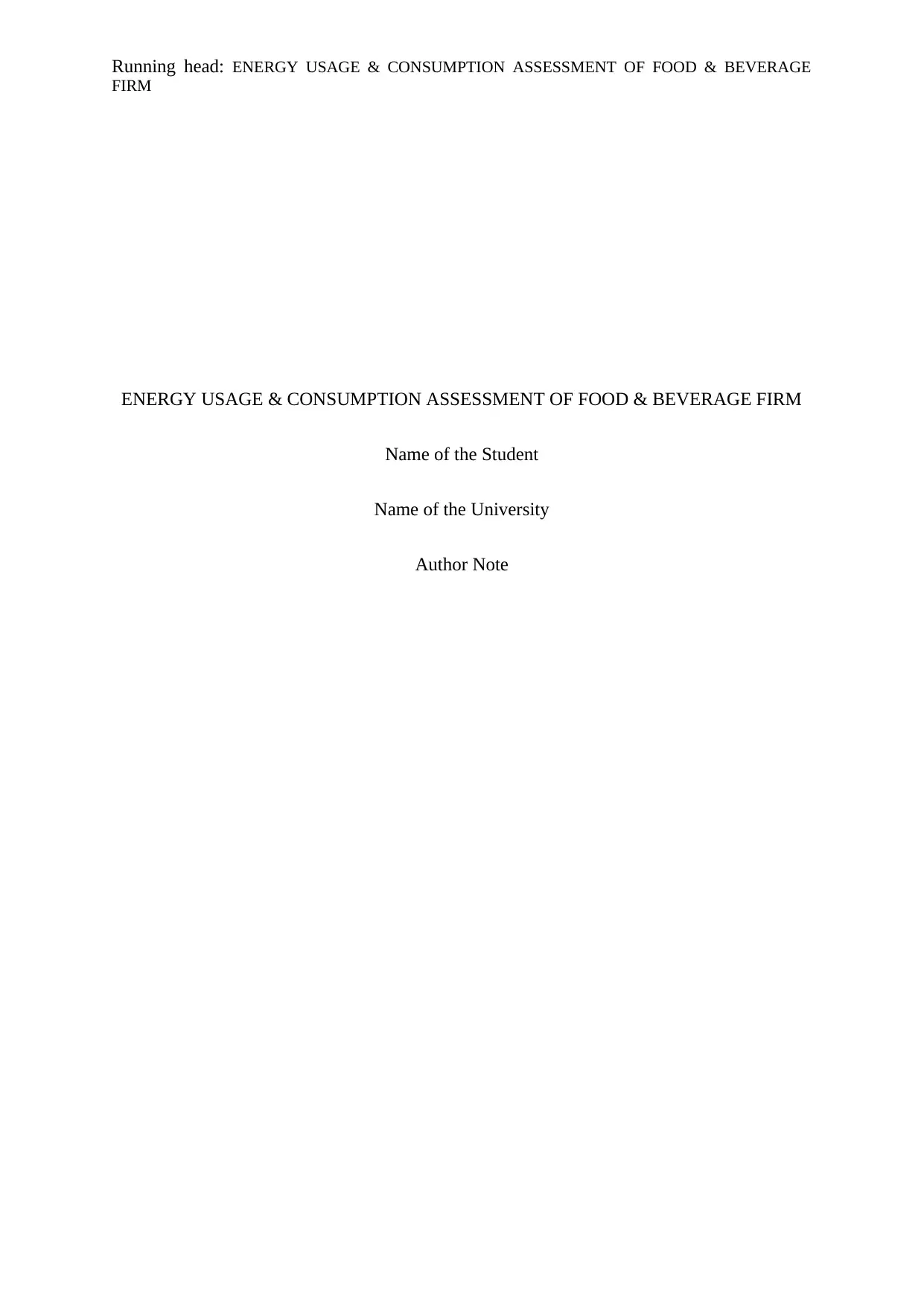
Running head: ENERGY USAGE & CONSUMPTION ASSESSMENT OF FOOD & BEVERAGE
FIRM
ENERGY USAGE & CONSUMPTION ASSESSMENT OF FOOD & BEVERAGE FIRM
Name of the Student
Name of the University
Author Note
FIRM
ENERGY USAGE & CONSUMPTION ASSESSMENT OF FOOD & BEVERAGE FIRM
Name of the Student
Name of the University
Author Note
Paraphrase This Document
Need a fresh take? Get an instant paraphrase of this document with our AI Paraphraser
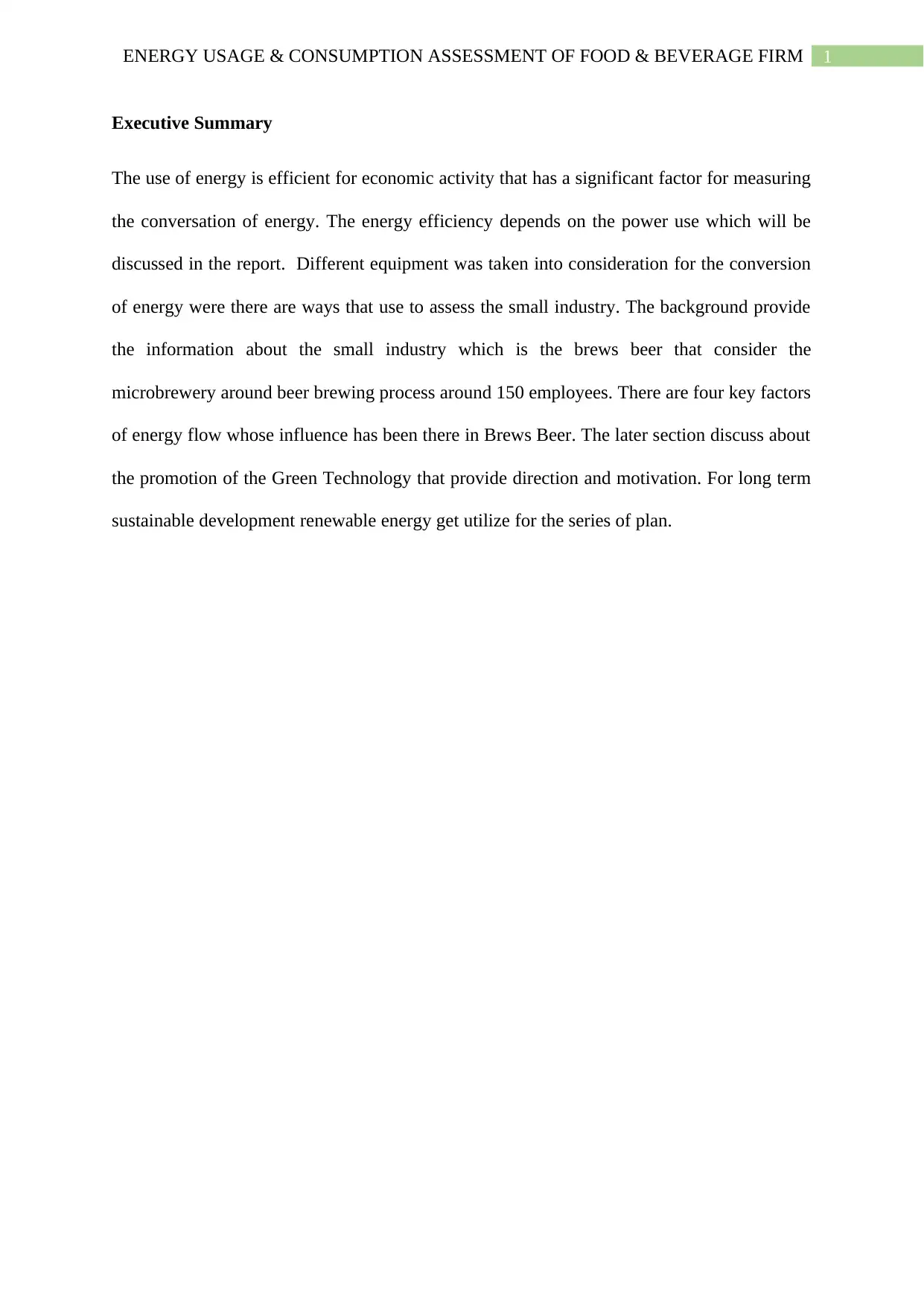
1ENERGY USAGE & CONSUMPTION ASSESSMENT OF FOOD & BEVERAGE FIRM
Executive Summary
The use of energy is efficient for economic activity that has a significant factor for measuring
the conversation of energy. The energy efficiency depends on the power use which will be
discussed in the report. Different equipment was taken into consideration for the conversion
of energy were there are ways that use to assess the small industry. The background provide
the information about the small industry which is the brews beer that consider the
microbrewery around beer brewing process around 150 employees. There are four key factors
of energy flow whose influence has been there in Brews Beer. The later section discuss about
the promotion of the Green Technology that provide direction and motivation. For long term
sustainable development renewable energy get utilize for the series of plan.
Executive Summary
The use of energy is efficient for economic activity that has a significant factor for measuring
the conversation of energy. The energy efficiency depends on the power use which will be
discussed in the report. Different equipment was taken into consideration for the conversion
of energy were there are ways that use to assess the small industry. The background provide
the information about the small industry which is the brews beer that consider the
microbrewery around beer brewing process around 150 employees. There are four key factors
of energy flow whose influence has been there in Brews Beer. The later section discuss about
the promotion of the Green Technology that provide direction and motivation. For long term
sustainable development renewable energy get utilize for the series of plan.

2ENERGY USAGE & CONSUMPTION ASSESSMENT OF FOOD & BEVERAGE FIRM
Table of Contents
Introduction................................................................................................................................3
Background................................................................................................................................3
Energy flow of Brews Beer........................................................................................................4
Usage..........................................................................................................................................4
Promotion with the Green Technology......................................................................................5
Equivalence forms of Energy Flow............................................................................................6
Conclusion..................................................................................................................................6
Recommendation........................................................................................................................7
References................................................................................................................................10
Table of Contents
Introduction................................................................................................................................3
Background................................................................................................................................3
Energy flow of Brews Beer........................................................................................................4
Usage..........................................................................................................................................4
Promotion with the Green Technology......................................................................................5
Equivalence forms of Energy Flow............................................................................................6
Conclusion..................................................................................................................................6
Recommendation........................................................................................................................7
References................................................................................................................................10
⊘ This is a preview!⊘
Do you want full access?
Subscribe today to unlock all pages.

Trusted by 1+ million students worldwide

3ENERGY USAGE & CONSUMPTION ASSESSMENT OF FOOD & BEVERAGE FIRM
Introduction
Energy is one of the most crucial resource that drives and defines the sustainability of
the firm and hence, it is recommended by different scholars to use it with great accuracy and
efficiency. The efficiency of the energy not only depends on the use of the power but the
equipment that are producing and using the energy. The discussed report will assess the use
of the energy used within the food and drink processing system. The conversion of energy
between different equipment and the way they are used will be assessed taking consideration
of a small industry will be discussed before concluding and offering recommendation for
energy sustainability.
Background
The subject of the paper is a small industry that brews beer and will take account of
its energy consumption and conversion in different processes involve in beer brewing
(Safdar, Ilyas and Malik, 2017). The organisation taken in consideration is a microbrewery
with around 150 employees to carry out the process of beer brewing. A hypothetical
organisation has been selected to discuss the case. The reason for selecting a hypothetical
organisation lays base on a microbrewery has multiple machineries and tools that are used to
complete the brewing process (Kubule et al., 2016). The most prominent energy consumers
are the refrigeration, packaging unit, air compressor, brewing unit, lighting systems, boilers
and others. The machineries and tools discussed are the prominent processes of the brewery
and the process that consumes most of the energy is the refrigeration process followed by the
air compressing, brewing, lightening, boiling and rest of the processes (Thollander et al,
2015).
The energy consumption and processing of each of the units that are part of the
brewing process can be calculated by using the assistance of the energy meter that are
Introduction
Energy is one of the most crucial resource that drives and defines the sustainability of
the firm and hence, it is recommended by different scholars to use it with great accuracy and
efficiency. The efficiency of the energy not only depends on the use of the power but the
equipment that are producing and using the energy. The discussed report will assess the use
of the energy used within the food and drink processing system. The conversion of energy
between different equipment and the way they are used will be assessed taking consideration
of a small industry will be discussed before concluding and offering recommendation for
energy sustainability.
Background
The subject of the paper is a small industry that brews beer and will take account of
its energy consumption and conversion in different processes involve in beer brewing
(Safdar, Ilyas and Malik, 2017). The organisation taken in consideration is a microbrewery
with around 150 employees to carry out the process of beer brewing. A hypothetical
organisation has been selected to discuss the case. The reason for selecting a hypothetical
organisation lays base on a microbrewery has multiple machineries and tools that are used to
complete the brewing process (Kubule et al., 2016). The most prominent energy consumers
are the refrigeration, packaging unit, air compressor, brewing unit, lighting systems, boilers
and others. The machineries and tools discussed are the prominent processes of the brewery
and the process that consumes most of the energy is the refrigeration process followed by the
air compressing, brewing, lightening, boiling and rest of the processes (Thollander et al,
2015).
The energy consumption and processing of each of the units that are part of the
brewing process can be calculated by using the assistance of the energy meter that are
Paraphrase This Document
Need a fresh take? Get an instant paraphrase of this document with our AI Paraphraser
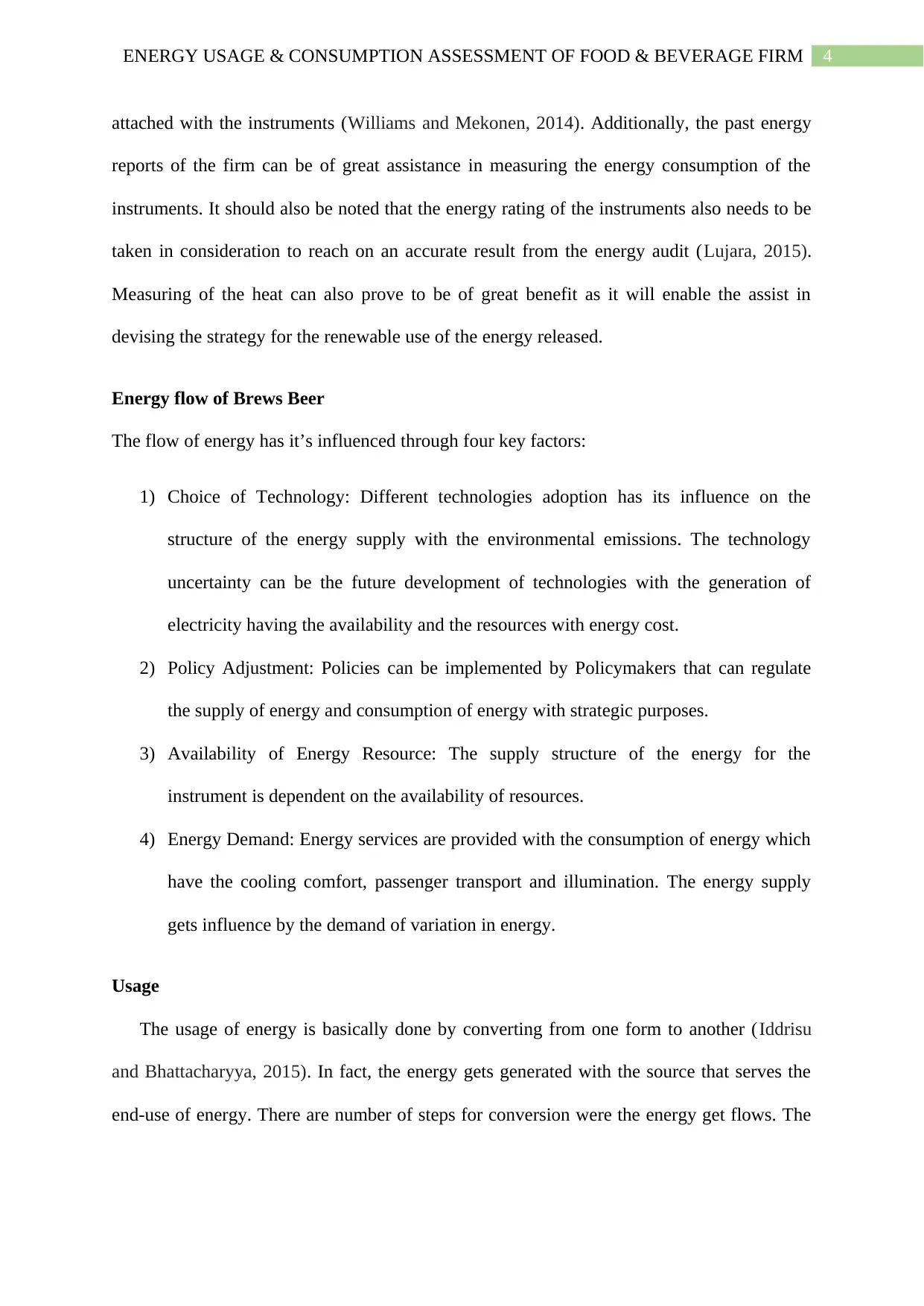
4ENERGY USAGE & CONSUMPTION ASSESSMENT OF FOOD & BEVERAGE FIRM
attached with the instruments (Williams and Mekonen, 2014). Additionally, the past energy
reports of the firm can be of great assistance in measuring the energy consumption of the
instruments. It should also be noted that the energy rating of the instruments also needs to be
taken in consideration to reach on an accurate result from the energy audit (Lujara, 2015).
Measuring of the heat can also prove to be of great benefit as it will enable the assist in
devising the strategy for the renewable use of the energy released.
Energy flow of Brews Beer
The flow of energy has it’s influenced through four key factors:
1) Choice of Technology: Different technologies adoption has its influence on the
structure of the energy supply with the environmental emissions. The technology
uncertainty can be the future development of technologies with the generation of
electricity having the availability and the resources with energy cost.
2) Policy Adjustment: Policies can be implemented by Policymakers that can regulate
the supply of energy and consumption of energy with strategic purposes.
3) Availability of Energy Resource: The supply structure of the energy for the
instrument is dependent on the availability of resources.
4) Energy Demand: Energy services are provided with the consumption of energy which
have the cooling comfort, passenger transport and illumination. The energy supply
gets influence by the demand of variation in energy.
Usage
The usage of energy is basically done by converting from one form to another (Iddrisu
and Bhattacharyya, 2015). In fact, the energy gets generated with the source that serves the
end-use of energy. There are number of steps for conversion were the energy get flows. The
attached with the instruments (Williams and Mekonen, 2014). Additionally, the past energy
reports of the firm can be of great assistance in measuring the energy consumption of the
instruments. It should also be noted that the energy rating of the instruments also needs to be
taken in consideration to reach on an accurate result from the energy audit (Lujara, 2015).
Measuring of the heat can also prove to be of great benefit as it will enable the assist in
devising the strategy for the renewable use of the energy released.
Energy flow of Brews Beer
The flow of energy has it’s influenced through four key factors:
1) Choice of Technology: Different technologies adoption has its influence on the
structure of the energy supply with the environmental emissions. The technology
uncertainty can be the future development of technologies with the generation of
electricity having the availability and the resources with energy cost.
2) Policy Adjustment: Policies can be implemented by Policymakers that can regulate
the supply of energy and consumption of energy with strategic purposes.
3) Availability of Energy Resource: The supply structure of the energy for the
instrument is dependent on the availability of resources.
4) Energy Demand: Energy services are provided with the consumption of energy which
have the cooling comfort, passenger transport and illumination. The energy supply
gets influence by the demand of variation in energy.
Usage
The usage of energy is basically done by converting from one form to another (Iddrisu
and Bhattacharyya, 2015). In fact, the energy gets generated with the source that serves the
end-use of energy. There are number of steps for conversion were the energy get flows. The
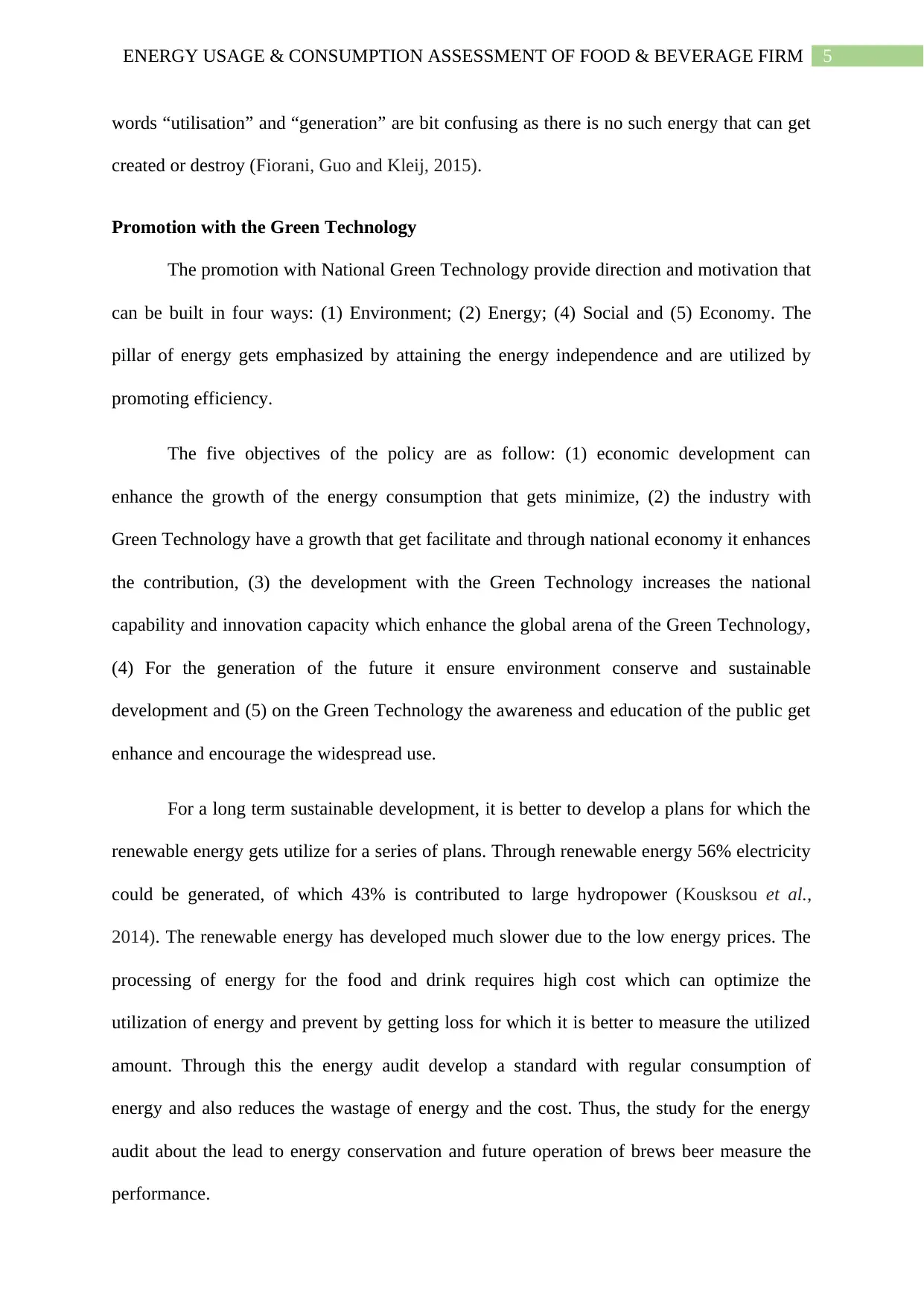
5ENERGY USAGE & CONSUMPTION ASSESSMENT OF FOOD & BEVERAGE FIRM
words “utilisation” and “generation” are bit confusing as there is no such energy that can get
created or destroy (Fiorani, Guo and Kleij, 2015).
Promotion with the Green Technology
The promotion with National Green Technology provide direction and motivation that
can be built in four ways: (1) Environment; (2) Energy; (4) Social and (5) Economy. The
pillar of energy gets emphasized by attaining the energy independence and are utilized by
promoting efficiency.
The five objectives of the policy are as follow: (1) economic development can
enhance the growth of the energy consumption that gets minimize, (2) the industry with
Green Technology have a growth that get facilitate and through national economy it enhances
the contribution, (3) the development with the Green Technology increases the national
capability and innovation capacity which enhance the global arena of the Green Technology,
(4) For the generation of the future it ensure environment conserve and sustainable
development and (5) on the Green Technology the awareness and education of the public get
enhance and encourage the widespread use.
For a long term sustainable development, it is better to develop a plans for which the
renewable energy gets utilize for a series of plans. Through renewable energy 56% electricity
could be generated, of which 43% is contributed to large hydropower (Kousksou et al.,
2014). The renewable energy has developed much slower due to the low energy prices. The
processing of energy for the food and drink requires high cost which can optimize the
utilization of energy and prevent by getting loss for which it is better to measure the utilized
amount. Through this the energy audit develop a standard with regular consumption of
energy and also reduces the wastage of energy and the cost. Thus, the study for the energy
audit about the lead to energy conservation and future operation of brews beer measure the
performance.
words “utilisation” and “generation” are bit confusing as there is no such energy that can get
created or destroy (Fiorani, Guo and Kleij, 2015).
Promotion with the Green Technology
The promotion with National Green Technology provide direction and motivation that
can be built in four ways: (1) Environment; (2) Energy; (4) Social and (5) Economy. The
pillar of energy gets emphasized by attaining the energy independence and are utilized by
promoting efficiency.
The five objectives of the policy are as follow: (1) economic development can
enhance the growth of the energy consumption that gets minimize, (2) the industry with
Green Technology have a growth that get facilitate and through national economy it enhances
the contribution, (3) the development with the Green Technology increases the national
capability and innovation capacity which enhance the global arena of the Green Technology,
(4) For the generation of the future it ensure environment conserve and sustainable
development and (5) on the Green Technology the awareness and education of the public get
enhance and encourage the widespread use.
For a long term sustainable development, it is better to develop a plans for which the
renewable energy gets utilize for a series of plans. Through renewable energy 56% electricity
could be generated, of which 43% is contributed to large hydropower (Kousksou et al.,
2014). The renewable energy has developed much slower due to the low energy prices. The
processing of energy for the food and drink requires high cost which can optimize the
utilization of energy and prevent by getting loss for which it is better to measure the utilized
amount. Through this the energy audit develop a standard with regular consumption of
energy and also reduces the wastage of energy and the cost. Thus, the study for the energy
audit about the lead to energy conservation and future operation of brews beer measure the
performance.
⊘ This is a preview!⊘
Do you want full access?
Subscribe today to unlock all pages.

Trusted by 1+ million students worldwide
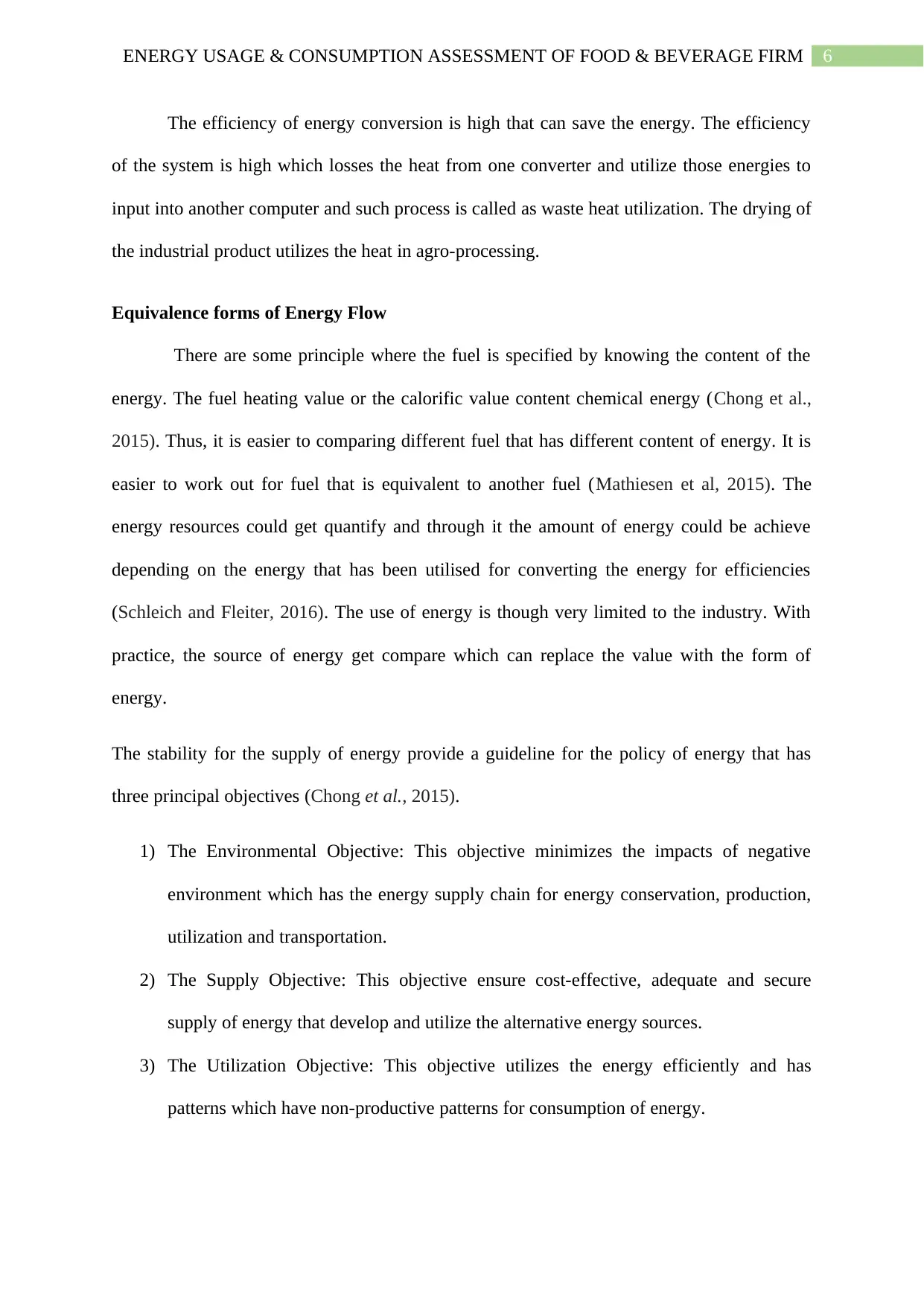
6ENERGY USAGE & CONSUMPTION ASSESSMENT OF FOOD & BEVERAGE FIRM
The efficiency of energy conversion is high that can save the energy. The efficiency
of the system is high which losses the heat from one converter and utilize those energies to
input into another computer and such process is called as waste heat utilization. The drying of
the industrial product utilizes the heat in agro-processing.
Equivalence forms of Energy Flow
There are some principle where the fuel is specified by knowing the content of the
energy. The fuel heating value or the calorific value content chemical energy (Chong et al.,
2015). Thus, it is easier to comparing different fuel that has different content of energy. It is
easier to work out for fuel that is equivalent to another fuel (Mathiesen et al, 2015). The
energy resources could get quantify and through it the amount of energy could be achieve
depending on the energy that has been utilised for converting the energy for efficiencies
(Schleich and Fleiter, 2016). The use of energy is though very limited to the industry. With
practice, the source of energy get compare which can replace the value with the form of
energy.
The stability for the supply of energy provide a guideline for the policy of energy that has
three principal objectives (Chong et al., 2015).
1) The Environmental Objective: This objective minimizes the impacts of negative
environment which has the energy supply chain for energy conservation, production,
utilization and transportation.
2) The Supply Objective: This objective ensure cost-effective, adequate and secure
supply of energy that develop and utilize the alternative energy sources.
3) The Utilization Objective: This objective utilizes the energy efficiently and has
patterns which have non-productive patterns for consumption of energy.
The efficiency of energy conversion is high that can save the energy. The efficiency
of the system is high which losses the heat from one converter and utilize those energies to
input into another computer and such process is called as waste heat utilization. The drying of
the industrial product utilizes the heat in agro-processing.
Equivalence forms of Energy Flow
There are some principle where the fuel is specified by knowing the content of the
energy. The fuel heating value or the calorific value content chemical energy (Chong et al.,
2015). Thus, it is easier to comparing different fuel that has different content of energy. It is
easier to work out for fuel that is equivalent to another fuel (Mathiesen et al, 2015). The
energy resources could get quantify and through it the amount of energy could be achieve
depending on the energy that has been utilised for converting the energy for efficiencies
(Schleich and Fleiter, 2016). The use of energy is though very limited to the industry. With
practice, the source of energy get compare which can replace the value with the form of
energy.
The stability for the supply of energy provide a guideline for the policy of energy that has
three principal objectives (Chong et al., 2015).
1) The Environmental Objective: This objective minimizes the impacts of negative
environment which has the energy supply chain for energy conservation, production,
utilization and transportation.
2) The Supply Objective: This objective ensure cost-effective, adequate and secure
supply of energy that develop and utilize the alternative energy sources.
3) The Utilization Objective: This objective utilizes the energy efficiently and has
patterns which have non-productive patterns for consumption of energy.
Paraphrase This Document
Need a fresh take? Get an instant paraphrase of this document with our AI Paraphraser

7ENERGY USAGE & CONSUMPTION ASSESSMENT OF FOOD & BEVERAGE FIRM
Conclusion
In this study, it is concluded that technology adoption has its influence on the
environmental emissions were energy get easily supply. The study has define the
sustainability of the form. The use of power has the energy efficiency which is equip by using
and producing energy. The hypothetical organisation has selected a microbrewery and has
tools that use the brewing process. When the energy get generated, the cost of the energy gets
available with the resources. The energy get consume with cooling comfort, passenger
transport and illumination which get influence by the energy variation. The prominent
processes for brewery is discussed through tools and machineries which the refrigeration
process consumes the energy which compresses the air. The conversation of energy is
basically done by converting from one form to another. The paper has also provided
information for long term sustainability development which develop a plan that utilize the
renewable energy for a series of plan.
Recommendation
The figure below recommended to identify the comparison between the specific
power and the specific energy which has a storage weight when energy get generated.
Conclusion
In this study, it is concluded that technology adoption has its influence on the
environmental emissions were energy get easily supply. The study has define the
sustainability of the form. The use of power has the energy efficiency which is equip by using
and producing energy. The hypothetical organisation has selected a microbrewery and has
tools that use the brewing process. When the energy get generated, the cost of the energy gets
available with the resources. The energy get consume with cooling comfort, passenger
transport and illumination which get influence by the energy variation. The prominent
processes for brewery is discussed through tools and machineries which the refrigeration
process consumes the energy which compresses the air. The conversation of energy is
basically done by converting from one form to another. The paper has also provided
information for long term sustainability development which develop a plan that utilize the
renewable energy for a series of plan.
Recommendation
The figure below recommended to identify the comparison between the specific
power and the specific energy which has a storage weight when energy get generated.
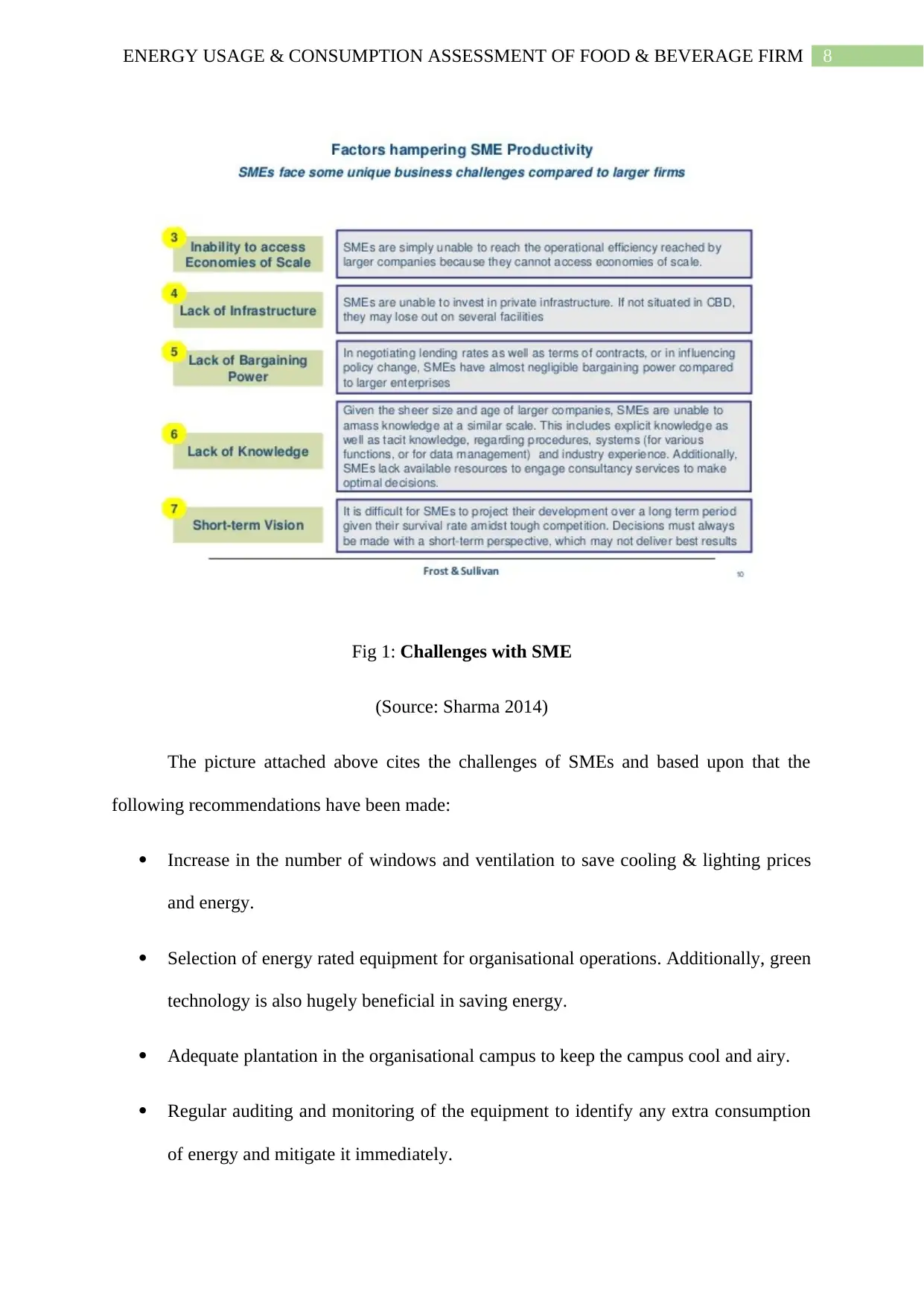
8ENERGY USAGE & CONSUMPTION ASSESSMENT OF FOOD & BEVERAGE FIRM
Fig 1: Challenges with SME
(Source: Sharma 2014)
The picture attached above cites the challenges of SMEs and based upon that the
following recommendations have been made:
Increase in the number of windows and ventilation to save cooling & lighting prices
and energy.
Selection of energy rated equipment for organisational operations. Additionally, green
technology is also hugely beneficial in saving energy.
Adequate plantation in the organisational campus to keep the campus cool and airy.
Regular auditing and monitoring of the equipment to identify any extra consumption
of energy and mitigate it immediately.
Fig 1: Challenges with SME
(Source: Sharma 2014)
The picture attached above cites the challenges of SMEs and based upon that the
following recommendations have been made:
Increase in the number of windows and ventilation to save cooling & lighting prices
and energy.
Selection of energy rated equipment for organisational operations. Additionally, green
technology is also hugely beneficial in saving energy.
Adequate plantation in the organisational campus to keep the campus cool and airy.
Regular auditing and monitoring of the equipment to identify any extra consumption
of energy and mitigate it immediately.
⊘ This is a preview!⊘
Do you want full access?
Subscribe today to unlock all pages.

Trusted by 1+ million students worldwide
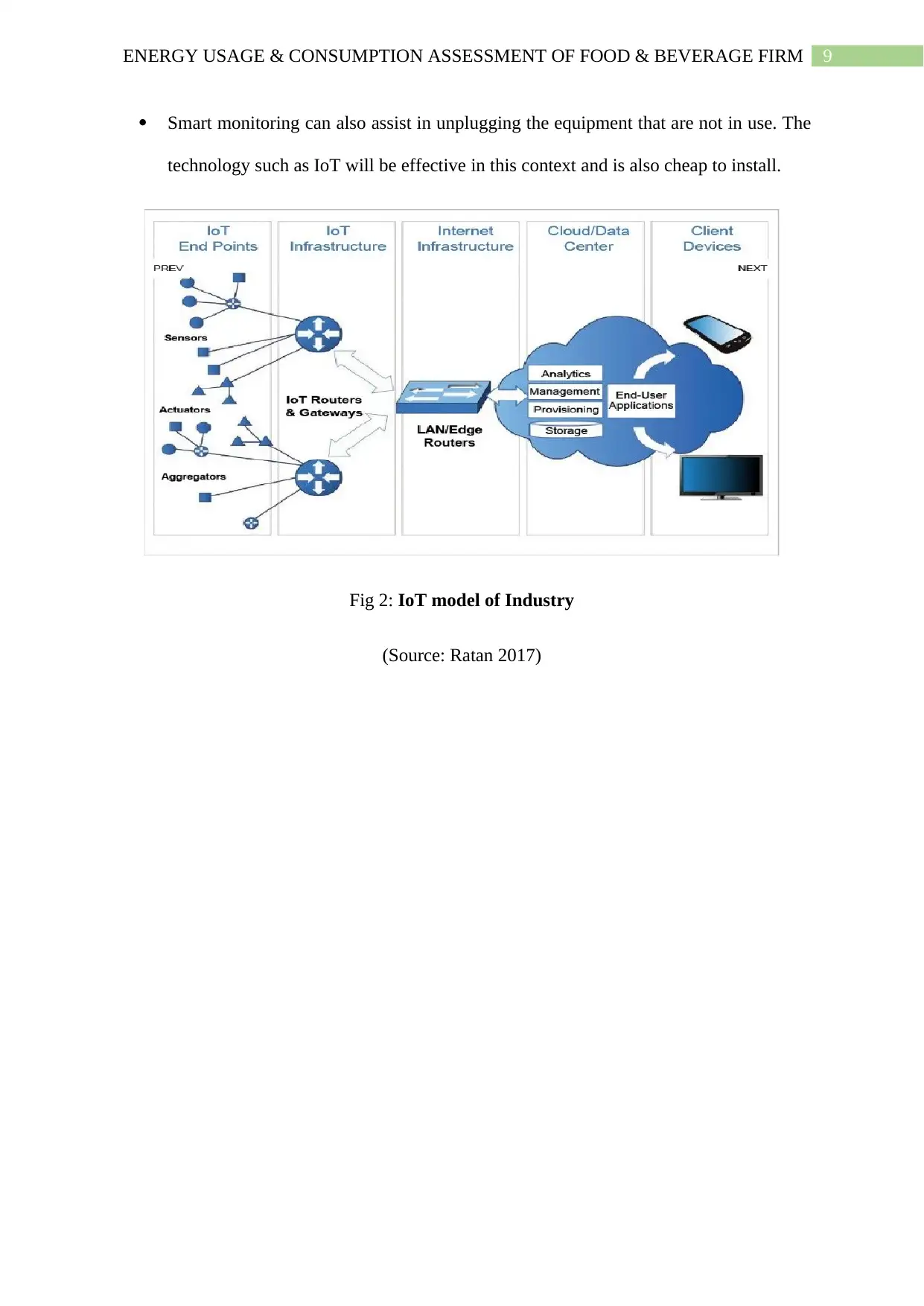
9ENERGY USAGE & CONSUMPTION ASSESSMENT OF FOOD & BEVERAGE FIRM
Smart monitoring can also assist in unplugging the equipment that are not in use. The
technology such as IoT will be effective in this context and is also cheap to install.
Fig 2: IoT model of Industry
(Source: Ratan 2017)
Smart monitoring can also assist in unplugging the equipment that are not in use. The
technology such as IoT will be effective in this context and is also cheap to install.
Fig 2: IoT model of Industry
(Source: Ratan 2017)
Paraphrase This Document
Need a fresh take? Get an instant paraphrase of this document with our AI Paraphraser

10ENERGY USAGE & CONSUMPTION ASSESSMENT OF FOOD & BEVERAGE FIRM
References
Chong, C., Ni, W., Ma, L., Liu, P. and Li, Z., 2015. The use of energy in Malaysia: Tracing
energy flows from primary source to end use. Energies, 8(4), pp.2828-2866.
Fiorani, G., Guo, W. and Kleij, A.W., 2015. Sustainable conversion of carbon dioxide: the
advent of organocatalysis. Green Chemistry, 17(3), pp.1375-1389.
Gallo, A.B., Simões-Moreira, J.R., Costa, H.K.M., Santos, M.M. and dos Santos, E.M., 2016.
Energy storage in the energy transition context: A technology review. Renewable and
sustainable energy reviews, 65, pp.800-822.
Iddrisu, I. and Bhattacharyya, S.C., 2015. Sustainable Energy Development Index: A multi-
dimensional indicator for measuring sustainable energy development. Renewable and
Sustainable Energy Reviews, 50, pp.513-530.
Kousksou, T., Bruel, P., Jamil, A., El Rhafiki, T. and Zeraouli, Y., 2014. Energy storage:
Applications and challenges. Solar Energy Materials and Solar Cells, 120, pp.59-80.
Kubule, A., Zogla, L., Ikaunieks, J. and Rosa, M., 2016. Highlights on energy efficiency
improvements: a case of a small brewery. Journal of cleaner production, 138, pp.275-286.
Lujara, N.K., 2015. Three Phase PWM Inverter for Low Rating Energy Efficient
Systems. International Journal of Electrical, Computer, Electronics and Communication
Engineering, 9(4), pp.400-406.
Mathiesen, B.V., Lund, H., Connolly, D., Wenzel, H., Østergaard, P.A., Möller, B., Nielsen,
S., Ridjan, I., Karnøe, P., Sperling, K. and Hvelplund, F.K., 2015. Smart Energy Systems for
coherent 100% renewable energy and transport solutions. Applied Energy, 145, pp.139-154.
References
Chong, C., Ni, W., Ma, L., Liu, P. and Li, Z., 2015. The use of energy in Malaysia: Tracing
energy flows from primary source to end use. Energies, 8(4), pp.2828-2866.
Fiorani, G., Guo, W. and Kleij, A.W., 2015. Sustainable conversion of carbon dioxide: the
advent of organocatalysis. Green Chemistry, 17(3), pp.1375-1389.
Gallo, A.B., Simões-Moreira, J.R., Costa, H.K.M., Santos, M.M. and dos Santos, E.M., 2016.
Energy storage in the energy transition context: A technology review. Renewable and
sustainable energy reviews, 65, pp.800-822.
Iddrisu, I. and Bhattacharyya, S.C., 2015. Sustainable Energy Development Index: A multi-
dimensional indicator for measuring sustainable energy development. Renewable and
Sustainable Energy Reviews, 50, pp.513-530.
Kousksou, T., Bruel, P., Jamil, A., El Rhafiki, T. and Zeraouli, Y., 2014. Energy storage:
Applications and challenges. Solar Energy Materials and Solar Cells, 120, pp.59-80.
Kubule, A., Zogla, L., Ikaunieks, J. and Rosa, M., 2016. Highlights on energy efficiency
improvements: a case of a small brewery. Journal of cleaner production, 138, pp.275-286.
Lujara, N.K., 2015. Three Phase PWM Inverter for Low Rating Energy Efficient
Systems. International Journal of Electrical, Computer, Electronics and Communication
Engineering, 9(4), pp.400-406.
Mathiesen, B.V., Lund, H., Connolly, D., Wenzel, H., Østergaard, P.A., Möller, B., Nielsen,
S., Ridjan, I., Karnøe, P., Sperling, K. and Hvelplund, F.K., 2015. Smart Energy Systems for
coherent 100% renewable energy and transport solutions. Applied Energy, 145, pp.139-154.
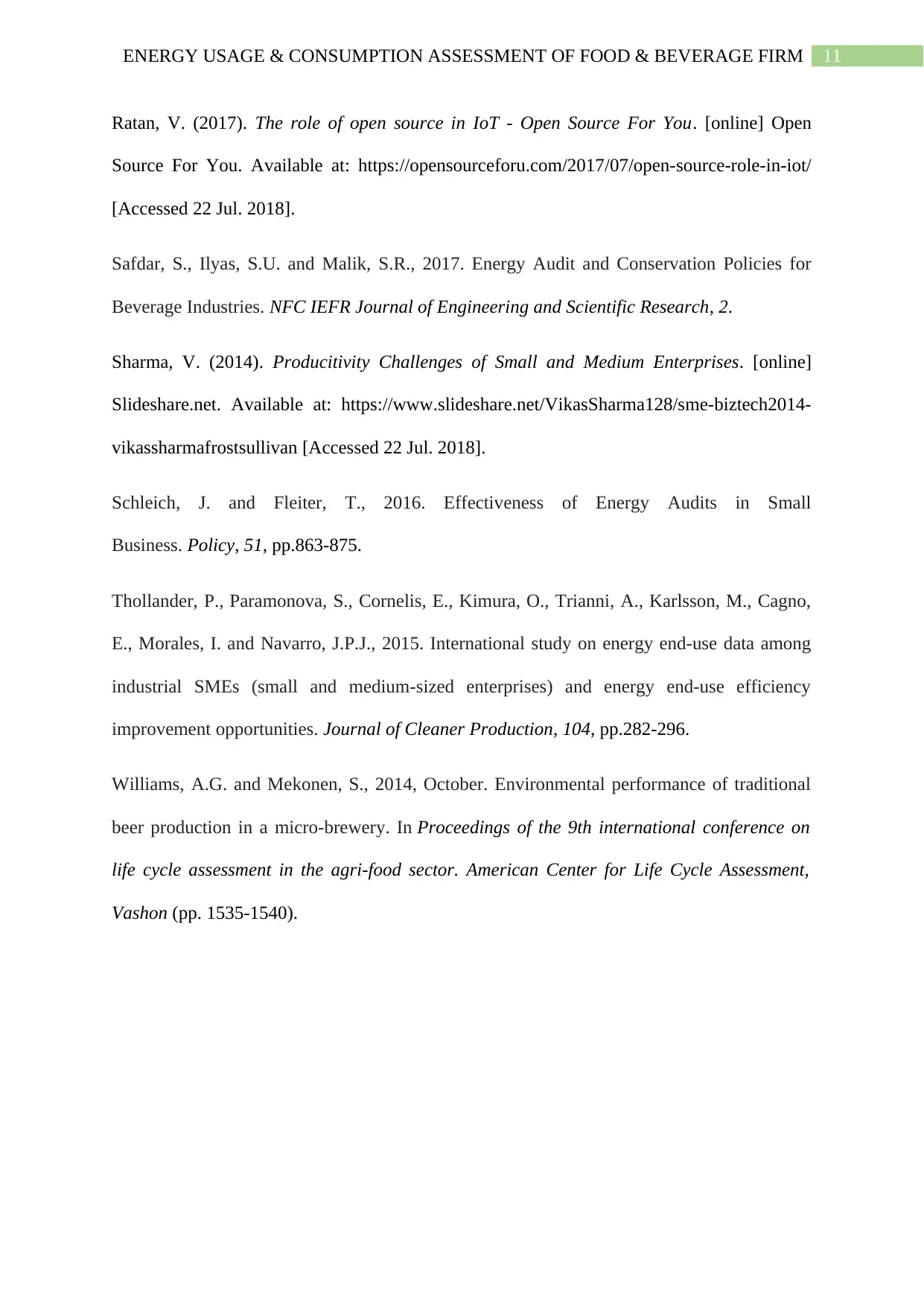
11ENERGY USAGE & CONSUMPTION ASSESSMENT OF FOOD & BEVERAGE FIRM
Ratan, V. (2017). The role of open source in IoT - Open Source For You. [online] Open
Source For You. Available at: https://opensourceforu.com/2017/07/open-source-role-in-iot/
[Accessed 22 Jul. 2018].
Safdar, S., Ilyas, S.U. and Malik, S.R., 2017. Energy Audit and Conservation Policies for
Beverage Industries. NFC IEFR Journal of Engineering and Scientific Research, 2.
Sharma, V. (2014). Producitivity Challenges of Small and Medium Enterprises. [online]
Slideshare.net. Available at: https://www.slideshare.net/VikasSharma128/sme-biztech2014-
vikassharmafrostsullivan [Accessed 22 Jul. 2018].
Schleich, J. and Fleiter, T., 2016. Effectiveness of Energy Audits in Small
Business. Policy, 51, pp.863-875.
Thollander, P., Paramonova, S., Cornelis, E., Kimura, O., Trianni, A., Karlsson, M., Cagno,
E., Morales, I. and Navarro, J.P.J., 2015. International study on energy end-use data among
industrial SMEs (small and medium-sized enterprises) and energy end-use efficiency
improvement opportunities. Journal of Cleaner Production, 104, pp.282-296.
Williams, A.G. and Mekonen, S., 2014, October. Environmental performance of traditional
beer production in a micro-brewery. In Proceedings of the 9th international conference on
life cycle assessment in the agri-food sector. American Center for Life Cycle Assessment,
Vashon (pp. 1535-1540).
Ratan, V. (2017). The role of open source in IoT - Open Source For You. [online] Open
Source For You. Available at: https://opensourceforu.com/2017/07/open-source-role-in-iot/
[Accessed 22 Jul. 2018].
Safdar, S., Ilyas, S.U. and Malik, S.R., 2017. Energy Audit and Conservation Policies for
Beverage Industries. NFC IEFR Journal of Engineering and Scientific Research, 2.
Sharma, V. (2014). Producitivity Challenges of Small and Medium Enterprises. [online]
Slideshare.net. Available at: https://www.slideshare.net/VikasSharma128/sme-biztech2014-
vikassharmafrostsullivan [Accessed 22 Jul. 2018].
Schleich, J. and Fleiter, T., 2016. Effectiveness of Energy Audits in Small
Business. Policy, 51, pp.863-875.
Thollander, P., Paramonova, S., Cornelis, E., Kimura, O., Trianni, A., Karlsson, M., Cagno,
E., Morales, I. and Navarro, J.P.J., 2015. International study on energy end-use data among
industrial SMEs (small and medium-sized enterprises) and energy end-use efficiency
improvement opportunities. Journal of Cleaner Production, 104, pp.282-296.
Williams, A.G. and Mekonen, S., 2014, October. Environmental performance of traditional
beer production in a micro-brewery. In Proceedings of the 9th international conference on
life cycle assessment in the agri-food sector. American Center for Life Cycle Assessment,
Vashon (pp. 1535-1540).
⊘ This is a preview!⊘
Do you want full access?
Subscribe today to unlock all pages.

Trusted by 1+ million students worldwide
1 out of 12
Your All-in-One AI-Powered Toolkit for Academic Success.
+13062052269
info@desklib.com
Available 24*7 on WhatsApp / Email
![[object Object]](/_next/static/media/star-bottom.7253800d.svg)
Unlock your academic potential
Copyright © 2020–2025 A2Z Services. All Rights Reserved. Developed and managed by ZUCOL.


